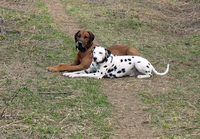Work on exposure and work at a distance. Team Wait
 A poorly socialized, nervous dog is hard to convince to accept a fixed position in an unfamiliar place. As a rule, such animals behave restlessly inside the car; bark and nervous, being left alone at the entrance to the store; “Roam” around an unknown room and have additional difficulties in the subsequent special training.
A poorly socialized, nervous dog is hard to convince to accept a fixed position in an unfamiliar place. As a rule, such animals behave restlessly inside the car; bark and nervous, being left alone at the entrance to the store; “Roam” around an unknown room and have additional difficulties in the subsequent special training.
During the period of the initial training of a puppy, you should not get too carried away with work for restraint, because it is difficult for a kid to concentrate his attention on something for a long time (see “Primary education of a puppy”). Representatives of mobile energetic breeds find it difficult to learn the “Wait!” Team even at the age of 5–6 months. Start by putting the dog on a leash and sitting near your left foot. Do not use either a toy or a treat, as this will tempt your pet to come to you. Give the command “Wait!”, Holding the palm of his left hand to the dog’s nose. Then, without releasing the leash, retreat by 0.5–1 meter and, starting with the right foot, slowly walk in a semicircle in front of the dog. Be sure to praise your pet with a soothing voice, often showing a gesture with an open palm.
If the dog arbitrarily sat down more conveniently, tucking his thigh under himself, easily pull the leash up and back, correcting the pose. If the dog has left the place, quickly run up and make him sit down in the starting position. At first, let your dog wait for further orders for a few seconds; Increase the exposure time gradually, bringing up to 1 minute, 5 minutes, etc. The permitting command to change the pose may be the transfer of the dog to a free position on the “Walk!” command, calling on the “To me!” command, laying the dog on the “Lie down !” etc.
During the first classes, move no further than the length of the leash allows (about 1.5 m), forcing the dog to be in a forced posture for only a short time. If the dog is waiting obediently, try to slowly lower the leash to the ground. Further, very gradually, the distance between you should increase. In this case, the trainer should closely monitor the behavior of your pet and, feeling his desire to leave the place, promptly correct these intentions.
At first, move backwards to keep the dog in view. And only later can you try to turn your back and move a few meters. Do not forget to constantly repeat: “Sit! Wait! If the dog still could not stand it and ran after you, quickly approach it, take it by the collar and take it to the place where the “escape” took place. The correction is supported by a jerk for a leash and pressing on the waist.
If the dog, in spite of everything, stubbornly ignores the command “Wait!”, You can try to lock it in place by force. Trainers call this technique “anchor the dog.” Use a long canvas leash (4–10 m), one end of which is fastened to the collar, and the other is wrapped around a tree or pillar at the height of the collar (i.e., 50–100 cm from the ground depending on the height of the dog). Work out the exercise for restraint, without unfastening the leash, until the dog understands your requirement to remain in place.
To reinforce the skill of the Sit! Wait! ”Introduce the following complications:
• the trainer moves away from a sitting dog in any direction up to 15 m, constantly increasing the exposure time;
• The trainer walks around the dog in an arc or in a circle, occasionally comes up to it, strokes and encourages “Good! Wait, good! ”;
• the trainer is running away from the dog;
• the trainer departs from the dog and hides in the shelter for a short time, and then returns and sincerely praises his pupil;
• The trainer and his assistants use various distracting stimuli: throw a ball or other aportizing object, try to seduce a dog with a treat, talk loudly among themselves, clap their hands, provoke a dog with a cat or walk in sight of another dog.
All the complicated exercises are first performed with a dog on a leash. For correction, sharply pull your pet down with a leash, reminding you in a loud voice “Sit!”. Without a jerk, the correction will be ineffective, and the skill will be unstable. If the dog gets used to voluntarily take off, it will be quite difficult to retrain it. Team “Sit! Wait! ”Is considered spent if your pet maintains the correct sitting position, despite the most various temptations.
Work on self-control and work at a distance After the dog learns to exercise self-control, it is taught to sit at a distance from the trainer. It is easier to practice this skill when the animal is in a standing position. Stand facing the dog and make it verbal. Next, work out the ability to take the desired position by the command “Sit!”, Gradually moving away from the pupil. It is important to constantly focus the attention of the animal on their actions.



